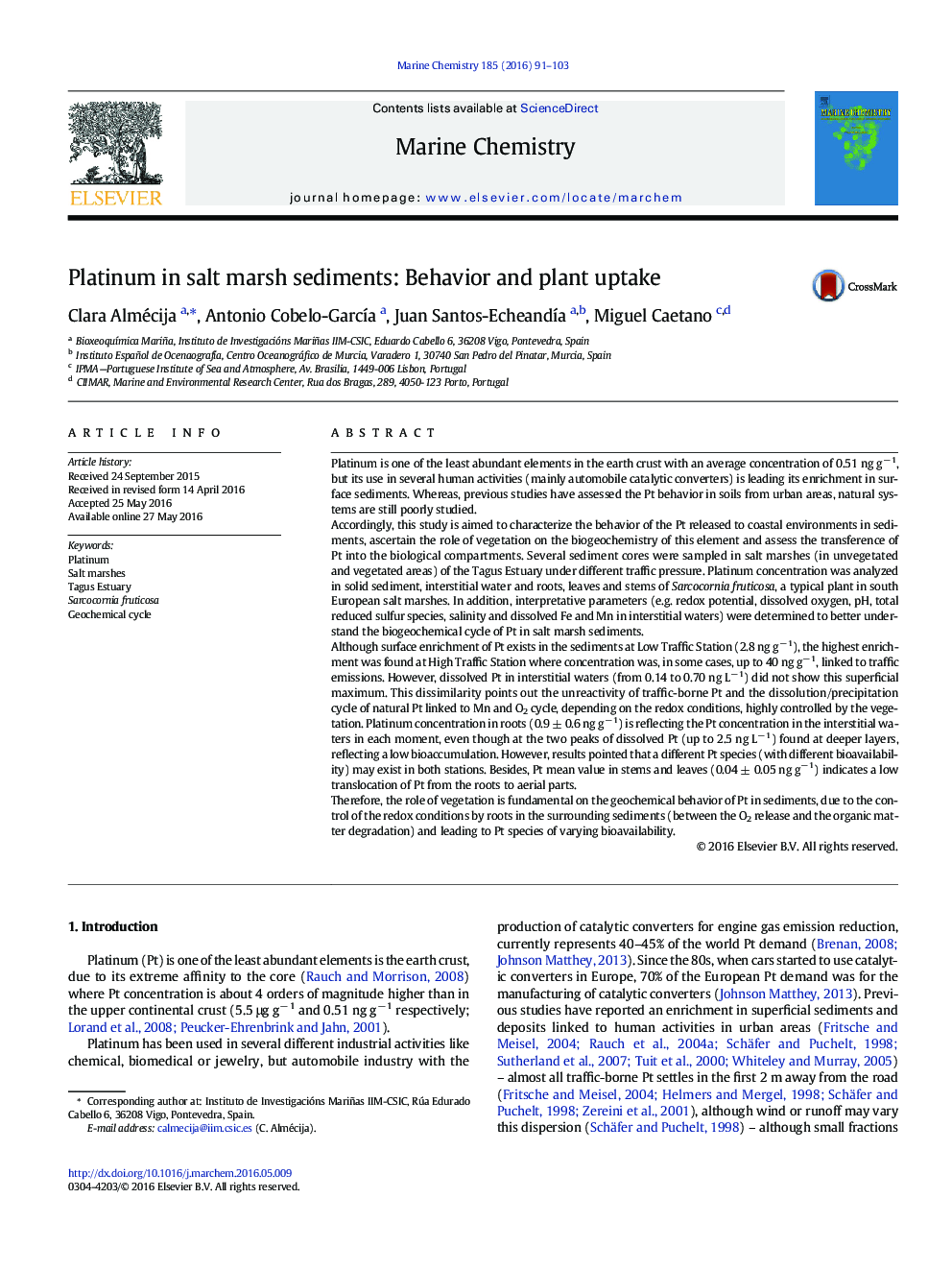| کد مقاله | کد نشریه | سال انتشار | مقاله انگلیسی | نسخه تمام متن |
|---|---|---|---|---|
| 1263149 | 1496651 | 2016 | 13 صفحه PDF | دانلود رایگان |
• Vegetation controls geochemistry in sediments and Pt behavior and chemical species.
• Traffic-borne Pt remains mostly inert in the first centimeters of sediments.
• Natural Pt and Mn annual cycles of dissolution and precipitation are deeply linked.
• Pt concentration in roots reflects Pt concentration in interstitial waters.
• Low translocation points to a lack of Pt incorporation to the food chain.
Platinum is one of the least abundant elements in the earth crust with an average concentration of 0.51 ng g− 1, but its use in several human activities (mainly automobile catalytic converters) is leading its enrichment in surface sediments. Whereas, previous studies have assessed the Pt behavior in soils from urban areas, natural systems are still poorly studied.Accordingly, this study is aimed to characterize the behavior of the Pt released to coastal environments in sediments, ascertain the role of vegetation on the biogeochemistry of this element and assess the transference of Pt into the biological compartments. Several sediment cores were sampled in salt marshes (in unvegetated and vegetated areas) of the Tagus Estuary under different traffic pressure. Platinum concentration was analyzed in solid sediment, interstitial water and roots, leaves and stems of Sarcocornia fruticosa, a typical plant in south European salt marshes. In addition, interpretative parameters (e.g. redox potential, dissolved oxygen, pH, total reduced sulfur species, salinity and dissolved Fe and Mn in interstitial waters) were determined to better understand the biogeochemical cycle of Pt in salt marsh sediments.Although surface enrichment of Pt exists in the sediments at Low Traffic Station (2.8 ng g− 1), the highest enrichment was found at High Traffic Station where concentration was, in some cases, up to 40 ng g− 1, linked to traffic emissions. However, dissolved Pt in interstitial waters (from 0.14 to 0.70 ng L− 1) did not show this superficial maximum. This dissimilarity points out the unreactivity of traffic-borne Pt and the dissolution/precipitation cycle of natural Pt linked to Mn and O2 cycle, depending on the redox conditions, highly controlled by the vegetation. Platinum concentration in roots (0.9 ± 0.6 ng g− 1) is reflecting the Pt concentration in the interstitial waters in each moment, even though at the two peaks of dissolved Pt (up to 2.5 ng L− 1) found at deeper layers, reflecting a low bioaccumulation. However, results pointed that a different Pt species (with different bioavailability) may exist in both stations. Besides, Pt mean value in stems and leaves (0.04 ± 0.05 ng g− 1) indicates a low translocation of Pt from the roots to aerial parts.Therefore, the role of vegetation is fundamental on the geochemical behavior of Pt in sediments, due to the control of the redox conditions by roots in the surrounding sediments (between the O2 release and the organic matter degradation) and leading to Pt species of varying bioavailability.
Figure optionsDownload as PowerPoint slide
Journal: Marine Chemistry - Volume 185, 20 October 2016, Pages 91–103
